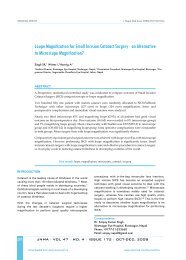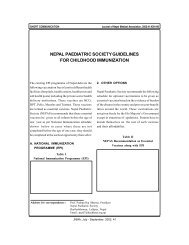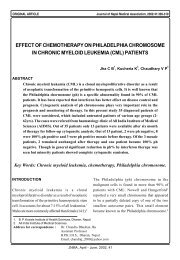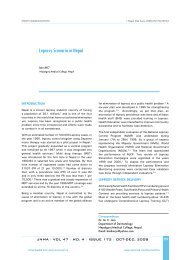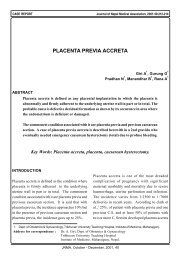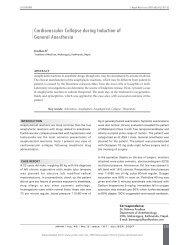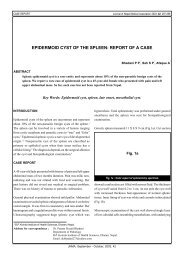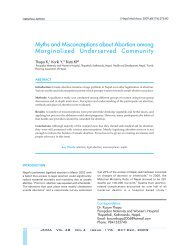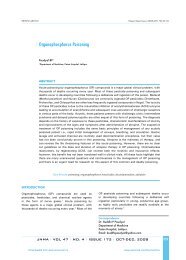jnama 177 final for press.FH11 - Journal of Nepal Medical Association
jnama 177 final for press.FH11 - Journal of Nepal Medical Association
jnama 177 final for press.FH11 - Journal of Nepal Medical Association
You also want an ePaper? Increase the reach of your titles
YUMPU automatically turns print PDFs into web optimized ePapers that Google loves.
Evidence <strong>for</strong> approval by a local Ethics Committee (<strong>for</strong><br />
both human as well as animal studies) must be supplied<br />
by the authors on demand. Animal experimental procedures<br />
should be as humane as possible and the details <strong>of</strong><br />
anesthetics and analgesics used should be clearly stated.<br />
The ethical standards <strong>of</strong> experiments must be in<br />
accordance with the guidelines provided by the CPCSEA<br />
(animal) and ICMR (human). The journal will not consider<br />
any paper which is ethically unacceptable. A statement<br />
on ethics committee permission and ethical practices<br />
must be included in all research articles under the ‘Materials<br />
and Methods’ section.<br />
Statistics<br />
Describe statistical methods with enough detaisl to enable<br />
a knowledgeable reader with access to the original data<br />
to verify the reported results. When possible, quantify<br />
findings and present them with appropriate indicators <strong>of</strong><br />
measurement error or uncertainty (such as confi dence<br />
intervals). Avoid relying solely on statistical hypothesis<br />
testing, such as P values, which fail to convey important<br />
in<strong>for</strong>mation about effect size. References <strong>for</strong> the design<br />
<strong>of</strong> the study and statistical methods should be to standard<br />
works when possible (with pages stated). Defi ne statistical<br />
terms, abbreviations, and most symbols. Specify the<br />
computer s<strong>of</strong>tware used.<br />
RESULTS<br />
Present your results in logical sequence in the text, tables,<br />
and illustrations, giving the main or most important fi<br />
ndings first. Do not repeat all the data in the tables or<br />
illustrations in the text; emphasize or summarize only<br />
the most important observations. Extra or supplementary<br />
materials and technical detail can be placed in an appendix<br />
where they will be accessible but will not interrupt the<br />
flow <strong>of</strong> the text, or they can be published solely in the<br />
electronic version <strong>of</strong> the journal.<br />
When data are summarized in the Results section, give<br />
numeric results not only as derivatives (<strong>for</strong> example,<br />
percentages) but also as the absolute numbers from<br />
which the derivatives were calculated, and specify the<br />
statistical methods used to analyze them. Restrict tables<br />
and figures to those needed to explain the argument <strong>of</strong><br />
the paper and to assess supporting data. Use graphs as<br />
an alternative to tables with many entries; do not duplicate<br />
data in graphs and tables. Avoid nontechnical uses <strong>of</strong><br />
technical terms in statistics, such as “random” (which<br />
implies a randomizing device), “normal,” “signifi cant,”<br />
“correlations,” and “sample.”<br />
Where scientifically appropriate, analyses <strong>of</strong> the data by<br />
such variables as age and sex should be included.<br />
DISCUSSION<br />
Emphasize the new and important aspects <strong>of</strong> the study<br />
and the conclusions that follow from them. Do not repeat<br />
in detail data or other in<strong>for</strong>mation given in the Introduction<br />
or the Results section. For experimental studies, it is<br />
useful to begin the discussion by summarizing briefly the<br />
main findings, then explore possible mechanisms or<br />
explanations <strong>for</strong> these findings, compare and contrast<br />
the results with other relevant studies, state the limitations<br />
<strong>of</strong> the study, and explore the implications <strong>of</strong> the fi ndings<br />
<strong>for</strong> future research and <strong>for</strong> clinical practice.<br />
CONCLUSIONS<br />
Link the conclusions with the goals <strong>of</strong> the study but<br />
avoid unqualified statements and conclusions not<br />
adequately supported by the data. In particular, avoid<br />
making statements on economic benefits and costs unless<br />
the manuscript includes the appropriate economic data<br />
and analyses. Avoid claiming priority or alluding to work<br />
that has not been completed. State new hypotheses<br />
when warranted, but label them clearly as such.<br />
REFERENCES<br />
We use Citing Medicine, The US National Library <strong>of</strong><br />
Medicine (NLM) Style Guide <strong>for</strong> Authors, Editors, and<br />
Publishers <strong>for</strong> references. It should be numbered<br />
consecutively in the order in which they are first mentioned<br />
in the text (not in alphabetic order). Identify references<br />
in text, tables, and legends by Arabic numerals in<br />
superscript with after the punctuation marks. References<br />
cited only in tables or figure legends should be numbered<br />
in accordance with the sequence established by the fi<br />
rst identification in the text <strong>of</strong> the particular table or<br />
JNMA I Vol 49 I No. 1 I Issue I<strong>177</strong> I JAN-MAR, 2010



